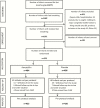Ambulatory Treatment of Fast Breathing in Young Infants Aged <60 Days: A Double-Blind, Randomized, Placebo-Controlled Equivalence Trial in Low-Income Settlements of Karachi
- PMID: 27941119
- PMCID: PMC5853586
- DOI: 10.1093/cid/ciw690
Ambulatory Treatment of Fast Breathing in Young Infants Aged <60 Days: A Double-Blind, Randomized, Placebo-Controlled Equivalence Trial in Low-Income Settlements of Karachi
Abstract
(See the Editorial Commentary by Jehan and Qazi on pages 190-1) BACKGROUND: Integrated Management of Childhood Illness recommends that young infants with isolated fast breathing be referred to a hospital for antibiotic treatment, which is often impractical in resource-limited settings. Additionally, antibiotics may be unnecessary for physiologic tachypnea in otherwise well newborns. We tested the hypothesis that ambulatory treatment with oral amoxicillin for 7 days was equivalent (similarity margin of 3%) to placebo in young infants with isolated fast breathing in primary care settings where hospital referral is often unfeasible.
Methods: This randomized equivalence trial was conducted in 4 primary health centers of Karachi, Pakistan. Infants presenting with isolated fast breathing and oxygen saturation ≥90% were randomly assigned to receive either oral amoxicillin or placebo twice daily for 7 days. Enrolled infants were followed on days 1-8, 11, and 14. The primary outcome was treatment failure by day 8, analyzed per protocol. The trial was stopped by the data safety monitoring board due to higher treatment failure rate and the occurrence of 2 deaths in the placebo arm in an interim analysis.
Results: Four hundred twenty-three infants fulfilled per protocol criteria in the amoxicillin arm and 426 in the placebo arm. Twelve infants (2.8%) had treatment failure in the amoxicillin arm and 25 (5.9%) in the placebo arm (risk difference, 3.1; P value .04). Two infants in the placebo arm died, whereas no deaths occurred in the amoxicillin arm. Other adverse outcomes, as well as the proportions of relapse, were evenly distributed across both study arms.
Conclusions: This trial failed to show equivalence of placebo to amoxicillin in the management of isolated fast breathing without hypoxemia or other clinical signs of illness in term young infants.
Clinical trials registration: NCT01533818.
Keywords: amoxicillin; clinical trial.; fast breathing; newborn; young infants.
© The Author 2016. Published by Oxford University Press for the Infectious Diseases Society of America. All rights reserved. For permissions, e-mail journals.permissions@oup.com.
Figures
Comment in
-
Treating Sick Young Infants With Only Fast Breathing With Oral Amoxicillin in Resource-Limited Settings: Taking the High Road?Clin Infect Dis. 2017 Jan 15;64(2):190-191. doi: 10.1093/cid/ciw695. Epub 2016 Oct 19. Clin Infect Dis. 2017. PMID: 27941117 Free PMC article. No abstract available.
Similar articles
-
Oral amoxicillin compared with injectable procaine benzylpenicillin plus gentamicin for treatment of neonates and young infants with fast breathing when referral is not possible: a randomised, open-label, equivalence trial.Lancet. 2015 May 2;385(9979):1758-1766. doi: 10.1016/S0140-6736(14)62285-6. Epub 2015 Apr 1. Lancet. 2015. PMID: 25842223 Clinical Trial.
-
Simplified antibiotic regimens for treatment of clinical severe infection in the outpatient setting when referral is not possible for young infants in Pakistan (Simplified Antibiotic Therapy Trial [SATT]): a randomised, open-label, equivalence trial.Lancet Glob Health. 2017 Feb;5(2):e177-e185. doi: 10.1016/S2214-109X(16)30335-7. Epub 2016 Dec 15. Lancet Glob Health. 2017. PMID: 27988146 Free PMC article. Clinical Trial.
-
A double blind community-based randomized trial of amoxicillin versus placebo for fast breathing pneumonia in children aged 2-59 months in Karachi, Pakistan (RETAPP).BMC Infect Dis. 2016 Jan 13;16:13. doi: 10.1186/s12879-015-1334-9. BMC Infect Dis. 2016. PMID: 26758747 Free PMC article. Clinical Trial.
-
Antibiotic therapy versus no antibiotic therapy for children aged 2 to 59 months with WHO-defined non-severe pneumonia and wheeze.Cochrane Database Syst Rev. 2021 Jan 20;1(1):CD009576. doi: 10.1002/14651858.CD009576.pub3. Cochrane Database Syst Rev. 2021. PMID: 33469915 Free PMC article.
-
Fluid restriction in the management of transient tachypnea of the newborn.Cochrane Database Syst Rev. 2021 Feb 18;2(2):CD011466. doi: 10.1002/14651858.CD011466.pub2. Cochrane Database Syst Rev. 2021. PMID: 33599990 Free PMC article.
Cited by
-
Comparison of 3 Days Amoxicillin Versus 5 Days Co-Trimoxazole for Treatment of Fast-breathing Pneumonia by Community Health Workers in Children Aged 2-59 Months in Pakistan: A Cluster-randomized Trial.Clin Infect Dis. 2019 Jul 18;69(3):397-404. doi: 10.1093/cid/ciy918. Clin Infect Dis. 2019. PMID: 30596964 Free PMC article. Clinical Trial.
-
Clinical Findings and Radiological Evaluation of WHO-Defined Severe Pneumonia Among Hospitalized Children.Cureus. 2023 Jan 15;15(1):e33804. doi: 10.7759/cureus.33804. eCollection 2023 Jan. Cureus. 2023. PMID: 36819341 Free PMC article.
-
Efficacy of Antibiotic Regimens for Pneumonia in Young Infants Aged 0-59 Days: A Systematic Review.Pediatrics. 2024 Aug 1;154(Suppl 1):e2024066588G. doi: 10.1542/peds.2024-066588G. Pediatrics. 2024. PMID: 39087803 Free PMC article.
-
Effect of provision of home-based curative health services by public sector health-care providers on neonatal survival: a community-based cluster-randomised trial in rural Pakistan.Lancet Glob Health. 2017 Aug;5(8):e796-e806. doi: 10.1016/S2214-109X(17)30248-6. Lancet Glob Health. 2017. PMID: 28716351 Free PMC article. Clinical Trial.
-
An analysis of clinical predictive values for radiographic pneumonia in children.BMJ Glob Health. 2020 Aug;5(8):e002708. doi: 10.1136/bmjgh-2020-002708. BMJ Glob Health. 2020. PMID: 32792409 Free PMC article.
References
-
- Lawn JE, Blencowe H, Oza S, et al. Lancet Every Newborn Study Group Every Newborn: progress, priorities, and potential beyond survival. Lancet 2014; 384:189–205. - PubMed
-
- Liu L, Oza S, Hogan D, Perin J, Rudan I, Lawn JE, et al. Global, regional, and national causes of child mortality in 2000–13, with projections to inform post-2015 priorities: an updated systematic analysis. Lancet 2014; 385:11. - PubMed
-
- Young Infants Clinical Signs Study Group. Clinical signs that predict severe illness in children under age 2 months: a multicentre study. Lancet 2008; 371:135–42. - PubMed
-
- World Health Organization. Integrated Management of Childhood Illness: chart booklet. Geneva, Switzerland: WHO, 2014.
-
- Kim SY. Neonatal respiratory distress: recent progress in understanding pathogenesis and treatment outcomes. Korean J Pediatr 2010; 53:1–6.
Publication types
MeSH terms
Substances
Associated data
LinkOut - more resources
Full Text Sources
Other Literature Sources
Medical


